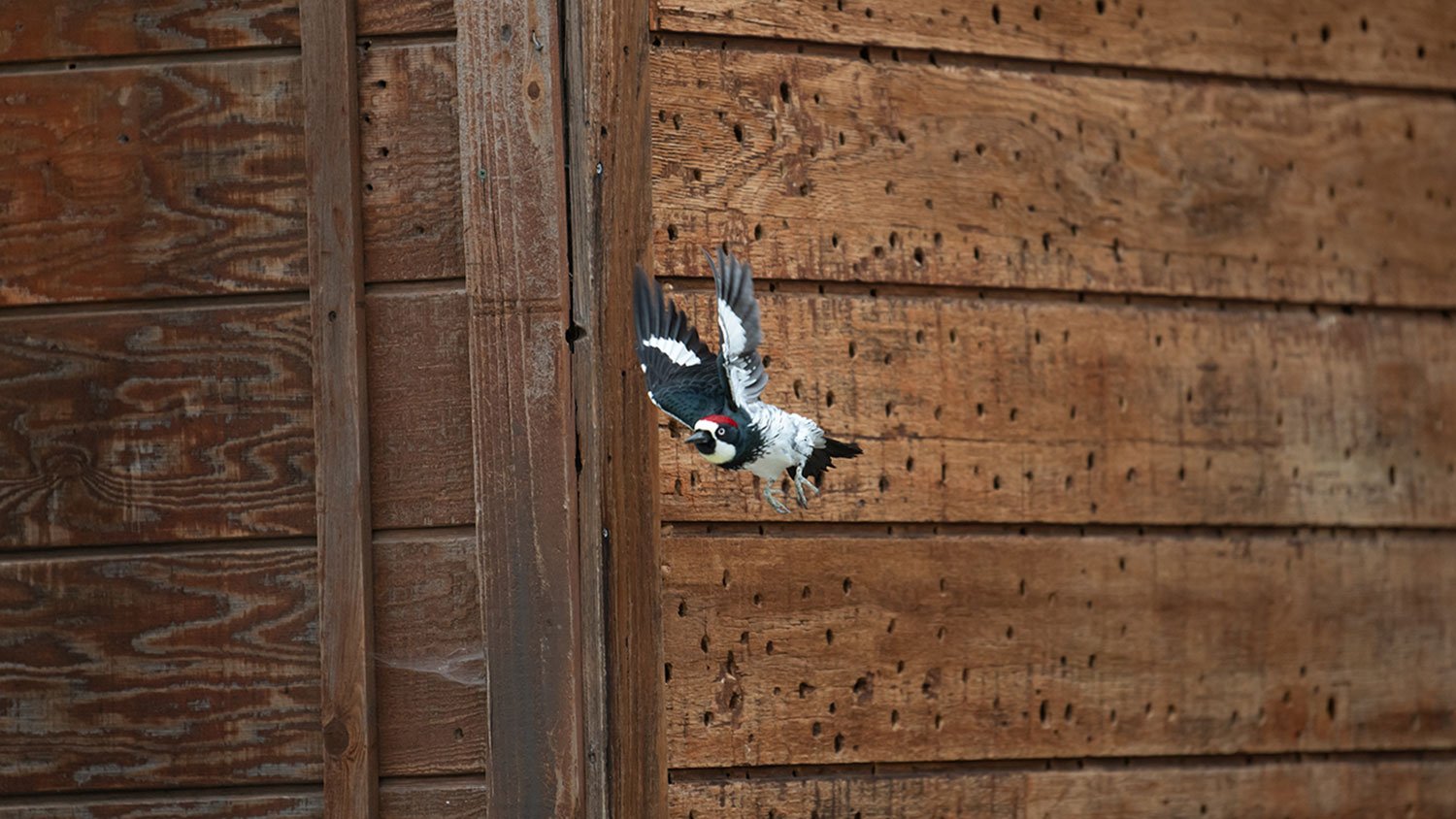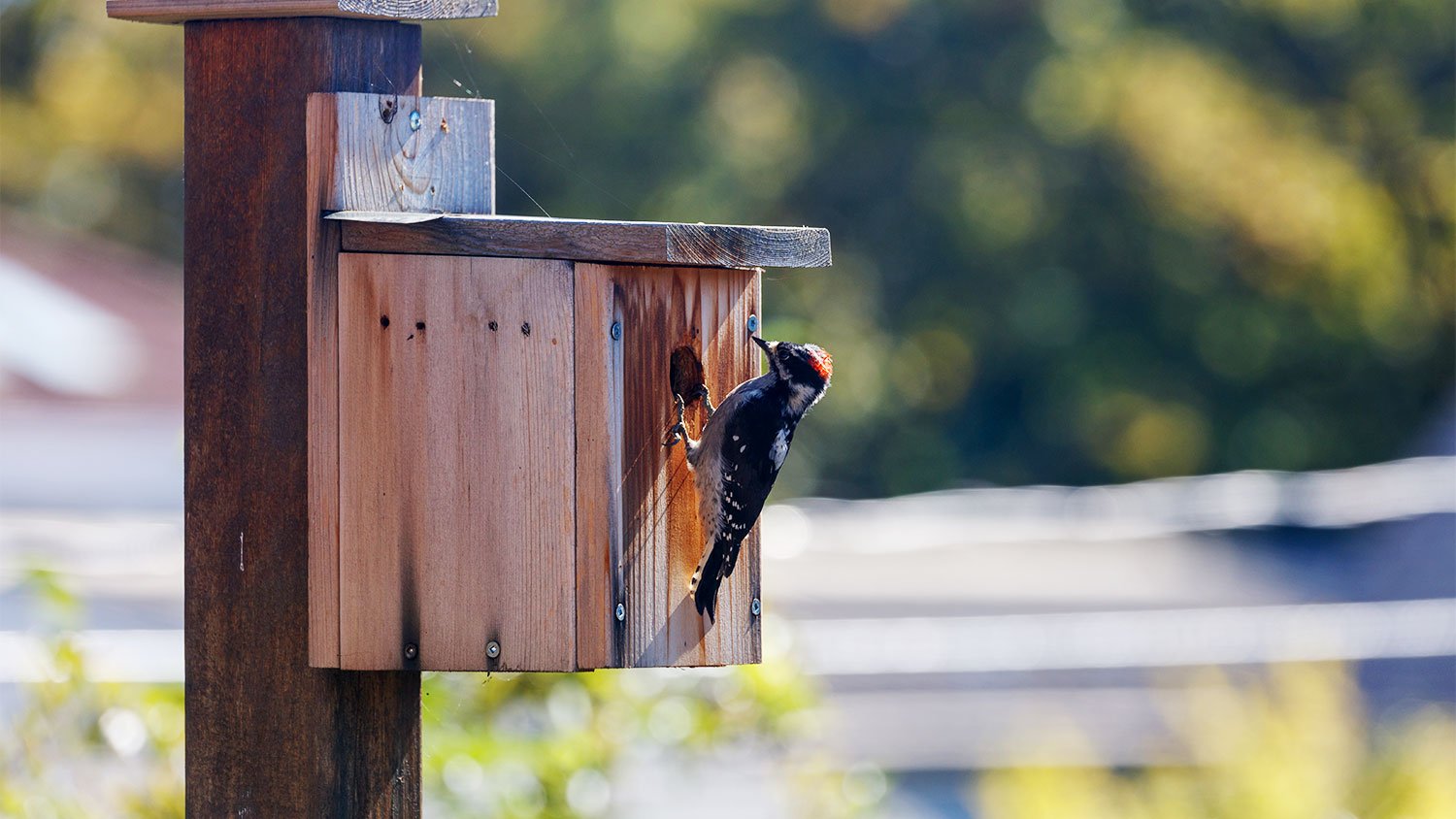
Your skunk removal cost will depend on several factors, including type, location, and more. Our guide will cover everything you need to know about skunk removal costs.
Time to move it along, Woody


Woodpeckers help eliminate pests and create nests for other forms of wildlife via the holes they peck in trees. But these federally protected birds don’t discern between a tree or important parts of your abode, like siding or decking, which can leave frustrated homeowners desperate for a humane solution.
The best course of action is to figure out how to get rid of woodpeckers before they wreak havoc on your home. Read on for ways to safely and humanely remove woodpeckers from your property.

One humane method is to frighten the woodpeckers away using reflective foil tape. Aluminum foil also works, but the tape is certainly easier to install. Start by placing a small amount of foil hung by a string near the area where the woodpecker spends the most time and gradually increase the amount as needed. When the wind blows, it pushes the foil tape around and makes the woodpecker think there’s movement in the trees.
Similar to the reflective foil, you can use wind chimes and pinwheels to cause distraction for woodpeckers. The sudden noise and unpredictable movement are scary to them, especially if it’s close to their nest or feeding zone. You can hang as many wind chimes and pinwheels as needed and gradually increase the number if the problem persists.
If the noise produced by your wind chimes is too subtle to scare off woodpeckers, then try introducing more racket with motion-activated speakers or noisemakers. You can situate these speakers wherever the woodpeckers hang out and see if it keeps them away. If the birds become accustomed to the noise, change up the settings and noises frequently.
Bird netting is a simple way to protect any area affected by woodpeckers and works by simply casting a large swath of netting that causes interference. Woodpeckers like the path of least resistance, so they may get frustrated with the netting and decide to move on.
Woodpeckers prefer trees over exterior walls, siding, roofs, and other manufactured structures, so if you notice woodpeckers in your trees, poking many holes for foraging, nesting, and attracting mates, consider wrapping your trunks in burlap bags or sacks. These bags are inexpensive and easy to apply. Just wrap up the tree as needed, and the woodpeckers will likely give up and go somewhere else.

Woodpeckers provide several clues they’re using your property as their new home. For starters, you can listen out for the near-constant pecking noises they make near their nests or when searching for food. Visually, you might notice their black and white feathers, although their marking can vary depending on the type of woodpecker.
Another sign is the presence of woodpecker holes. Woodpeckers leave these distinct holes wherever they nest or look for food. There are three types of woodpecker holes, including:
Foraging holes: These are small, deep holes that occur in a vertical or horizontal line. You typically see more holes in older wood versus fewer holes in newer wood.
Drumming holes: These holes are typically caused by male woodpeckers looking to “drum” up a mate and look like numerous small, shallow holes in a cluster.
Roosting holes: Otherwise known as nesting holes or excavation holes, these are much larger than the other types. Roosting holes are fairly large in diameter, up to five centimeters, and sometimes resemble an upside-down L.
These birds peck anything they get their beaks on, but particularly wood. That means your wood siding, fences, decking, and utility poles are all at risk for woodpecker damage. Though these holes start small, they accrue serious cosmetic damage over time. Additionally, woodpeckers can eventually open up entry points into your home, leading to invading pests, leaks, mold growth, and other problems. Though they rely exclusively on wood, these birds accidentally pierce plumbing and electrical lines while foraging or building a nest.
It is worth noting, however, that woodpeckers much prefer dead trees to anything on your property.

Once woodpeckers flee your property in search of greener pastures, you can deter future visitors by following these methods.
Fill holes: Use epoxy putty or wood putty to fix the holes woodpeckers leave behind as they search for food, build nests, or tempt mates. Woodpeckers return to the same areas each year during migration, so filling these holes deters them from coming straight back to your yard.
Conduct necessary repairs: Woodpeckers cause serious damage to roof shingles and siding, so you may need to replace these features as a contractor recommends—plus, it removes any temptation for building nests next season.
Have your trees inspected: Woodpeckers primarily love dying and diseased trees, indicating you may need to conduct a professional tree inspection with a local arborist to identify any issues.
Handle pest problems: Woodpeckers eat carpenter ants, termites, grubs, and any other insect they come across, so you may benefit from hiring an exterminator to remove their favorite food sources.
Paint wood siding: Studies indicate that paint fills in gaps that house pests, thus discouraging predators like these birds from dropping by.
Install nest boxes: If woodpeckers still visit each year, give them somewhere else to live instead of in your siding or your trees. Place cavity-type nest boxes throughout your property, staying close to the epicenter of damage. Fill these boxes with sawdust to encourage the birds to excavate and make a new home.
Woodpeckers are attracted to nut-bearing trees, serviceberry, dogwood, and elderberry plants. They may also be attracted to metal surfaces like tin roofs and aluminum siding because they communicate using the percussion sounds their beaks make and metal makes an excellent drum for them.
The above steps cater to DIYers and are easily accomplished by both seasoned homeowners and amateur renovators. However, if these simple deterrence procedures do nothing to alleviate the problem, bring in a local bird control company to help. They are experienced in locating and deterring active woodpecker populations in residential areas.
Bird removal costs $50 to $100 per hour, but some experts might adjust prices per the target species. On average, woodpeckers cost $450 to $650 to remove.
Additionally, hiring a pro to remove a bird’s nest costs anywhere from $100 to $2,000, depending on accessibility, the number of specimens using the nest, and any post-removal cleanup services rendered. Woodpecker nests fall on the low-to-medium end of that price range, as they don’t travel in large flocks like pigeons and other species.
Never move a nest with eggs. It is always best to wait for birds to abandon the nest before you attempt to remove it.
Kimberly Meis 2 reviews 5 months ago Professional, fast, on time, good experience! I highly recommend this company. BJ & Kim Garcia-Meis 1 Julia Bonds 20 reviews·1 photo 5 months ago Very good experience. Same person delt with me from the first phone call through repairs of my furnace. He...
Timely with quote and installation. When another layer of shingles was discovered at installation, promptly texted me photo showing extra layer of shingles discovered and quoted me a fair additional fee for the removal. Very happy customer.
Fantastic, Raul and his crew were efficient and did a wonderful job. We really appreciated how conscientious they were of all our animals and the need to keep doors closed. They were very personable and friendly.
Fantastic job. Rich Patterson and Richis Tree Service removed huge trees along a difficult to access creek bed. They completed the work in less time than I expected and for a very fair price. This is a job that the "big boy" tree removal companies wouldn't touch. "Too hard," they whined....
The crew arrived on time and got right to work. They marked sprinkler locations to avoid hitting them with the bucket truck. They stayed off the edge of the pavers, which had been damaged by past tree crews. They shaped and trimmed the trees as promised and hauled away everything they...
From average costs to expert advice, get all the answers you need to get your job done.

Your skunk removal cost will depend on several factors, including type, location, and more. Our guide will cover everything you need to know about skunk removal costs.

When budgeting for possum removal costs, consider number of animals, location, method of removal, and whether you do it yourself or hire a professional.

When calculating wildlife removal costs, you’ll need to consider the type, size, and amount of animals. Our guide will show you the wildlife removal cost.

Keep your pets, livestock, and poultry safe by learning how to keep wolves away. Plus, find out what’s attracting them to your home in the first place.

If there’s an animal in your vent, who do you call?. Here’s what to do if a critter gets loose in your HVAC system vents.

There are different types of iguanas in the U.S., some native and others invasive. Here's what homeowners need to know.